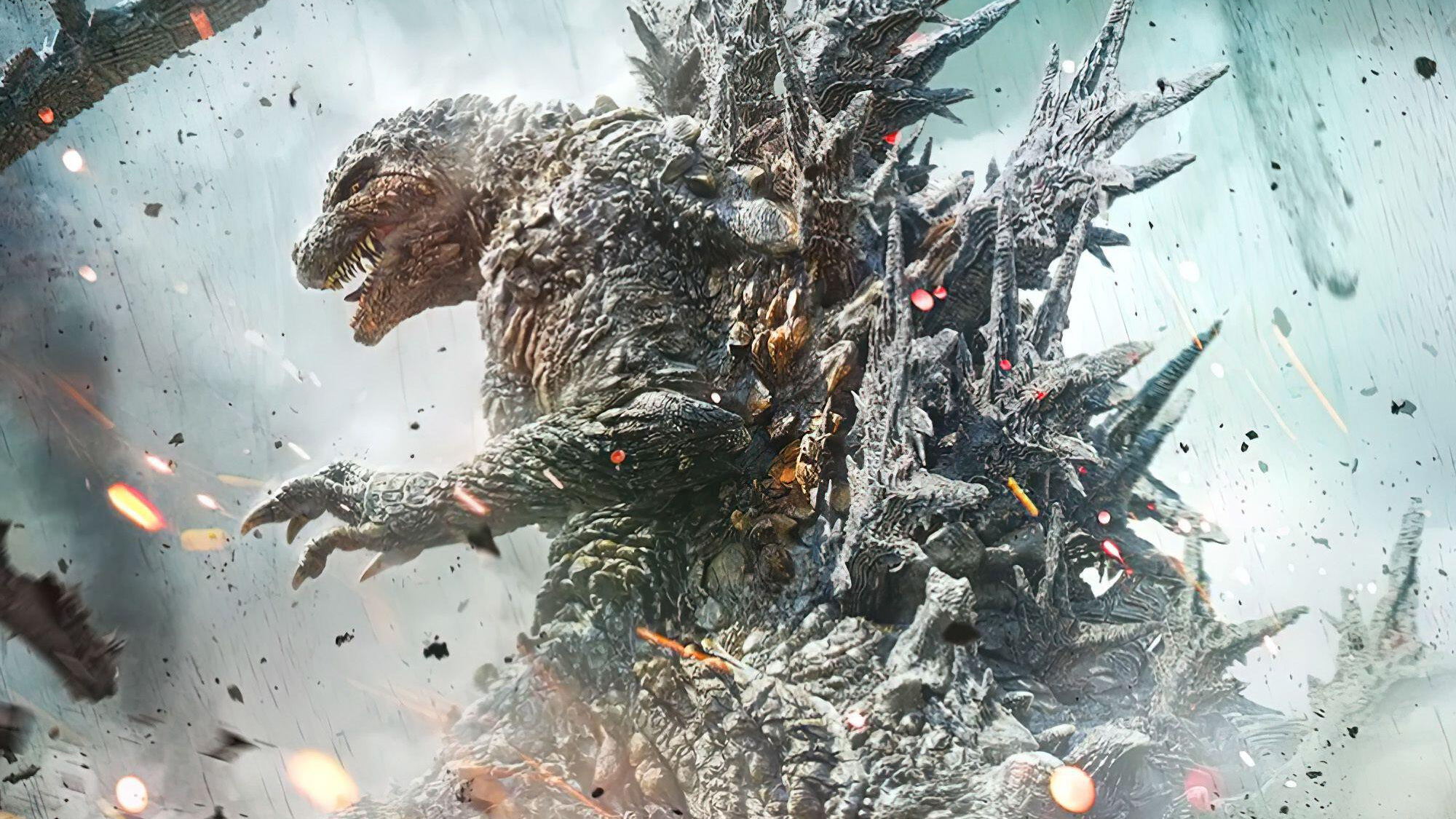As soon as the credits rolled for Godzilla Minus One, I knew that I had seen a truly special film. It is, quite simply, a tour de force of moviemaking, a cinematic triumph. I say this not only as a lifelong fan of the “Big-G” who grew up on a steady diet of the giant monster adventures known in Japan as the kaiju genre, but as someone who savors the moviegoing experience and respects the power of film to tell compelling stories in a way that no other medium can quite match.
Godzilla’s filmography includes everything from the haunting nuclear allegory of the original 1954 classic to the campy monster mash of the 2021 Hollywood spectacle Godzilla vs. Kong, which cheerfully abandons any pretense to high cinema. In Godzilla Minus One, director and writer Takashi Yamazaki successfully recaptures the power and pathos of the 1954 film by grappling with the searing trauma endured by post-World War II Japan as that nation came to grips with the appalling cost of its imperial aggression.
It’s impossible to properly discuss the themes of this movie without delving into some crucial aspects of the characters and plot, so I urge you to see it in theaters if at all possible before reading my analysis. Even if you don’t normally enjoy “creature features,” Godzilla Minus One can be enjoyed as a powerful and affecting human drama. It is also a remarkably life-affirming film.
The protagonist is Kōichi Shikishima (played masterfully by Ryunosuke Kamiki). Kōichi is a former kamikaze pilot who, in the final days of the war, refused to go through with his suicide mission. In a subsequent encounter with Godzilla, Kōichi’s fear and hesitation leads to the deaths of many of his fellow Japanese servicemen. Wracked with survivor’s guilt, Kōichi returns to Tokyo and struggles to build a life for himself amid the charred ruins of his neighborhood, laid to waste by the American firebombing campaign. Despite his initial misgivings, he takes in a homeless woman named Noriko (Minami Hamabe), and together they adopt a baby girl named Akiko (Sae Nagatani), who was orphaned by the air raids.
In response to this militaristic culture of death, the film makes a clarion call to embrace life.
All the while, Kōichi is being crushed under the weight of self-reproach, suffering nightmares, and traumatic episodes of depersonalization. He feels ashamed to have survived the war. He accuses himself of being unworthy to enjoy family life when so many other men perished in the fighting. Noriko tries to comfort him, saying that everyone who survived the war survived for a purpose. Indeed, without Kōichi’s timely compassion, Noriko and Akiko would perhaps have died of starvation on the streets. The raw emotions on display in these scenes are palpable. I completely forgot that I was watching a foreign-language film with subtitles.
While Yamazaki effectively portrays the scale of the destruction and death unleashed by a vengeful United States on helpless Japanese civilians, he also acknowledges Japan’s own wartime mistakes. In one key scene, Kōichi’s friend, former weapons engineer Kenji Noda (Hidetaka Yoshioka), remarks how the Japanese regime was “too cheap” with life during the conflict, wasting men in pointless battles and then resorting to the horrific suicide tactics of the kamikaze. In response to this militaristic culture of death, the film makes a clarion call to embrace life. The only way to respond to inhuman tragedy and build a better future for all mankind is to stop “fighting to the death” and begin fighting for life.
This is a message perfectly compatible with our Catholic faith. It is also starkly countercultural, as you can see by simply turning on the news. Wars fueled by nationalism and ethnic hatred once again spread across our world. In the increasingly post-Christian West, grisly procedures such as abortion and euthanasia are promoted as ways to “humanely” end suffering by ending life. The shocking rise in the suicide rate in America testifies to the fact that many now see no other response to suffering and pain except despair. But as Catholics, we can witness against the spread of the culture of death by becoming, to paraphrase the popular prayer attributed to St. Francis, instruments of God’s peace, sowing love instead of hate, pardon instead of injury, and hope instead of despair.
Godzilla Minus One does not shy away from depicting the ugly reality of human misery in a fallen world, nor does it offer easy answers. Evil is all around us, both in the form of human evils, like hatred and war, and natural evils, like hurricanes and earthquakes. (Indeed, what is Godzilla itself but a blend of these two evils: a walking natural disaster made far more potent and dangerous by man’s misuse of atomic power.) But as the film demonstrates in poignant fashion, such evils do not have the final word. We can choose to live life to the fullest in spite and in the midst of immense tragedy and suffering. This choice to embrace life, the choice to cling to hope, is indeed the lodestone of the film.

Just when Kōichi seems to be settling into a new domestic tranquility, Godzilla returns, mutated into a skyscraper-sized monstrosity by the American nuclear tests. The creature wreaks apocalyptic havoc. Conventional weapons are like toys against Godzilla, which uses an atomic heat ray to sweep away all before it. Believing Noriko to have been killed in Godzilla’s assault, Kōichi sees no reason left to live. In his grief, he seeks to both strike back at Godzilla and to atone for his wartime “disgrace”—he resolves to fly a solo kamikaze mission against the monster in a last-ditch bid to kill it once and for all.
Kōichi successfully flies his prototype aircraft packed with explosives into Godzilla’s mouth, causing the monster’s heat ray to overload and destroy it from the inside. But at the last moment, Kōichi uses the plane’s ejection seat, finally making peace with his survivor’s guilt and choosing to live for little Akiko rather than sacrifice himself for revenge or “honor.” During the celebration that follows the unlikely victory, Kōichi receives a telegram and rushes to a hospital with Akiko where they find that Noriko is in fact alive! The family embraces, reunited in astonished joy as they prepare to face an uncertain future.
The ending of Godzilla Minus One is a brilliant example of a eucatastrophe, to borrow a term coined by J.R.R. Tolkien. In his landmark essay “On Fairy-Stories,” Tolkien defined eucatastrophe as “the joy of the happy ending: or more correctly of the good catastrophe, the sudden joyous ‘turn.’” Eucatastrophe “does not deny the existence of dyscatastrophe, of sorrow and failure: the possibility of these is necessary to the joy of deliverance; it denies (in the face of much evidence, if you will) universal final defeat and in so far is evangelium, giving a fleeting glimpse of Joy, Joy beyond the walls of the world, poignant as grief.” Whether he consciously intended this or not, director Takashi Yamazaki has tapped into the power of eucatastrophe in a way I have seldom seen in contemporary science fiction.
Godzilla Minus One is an extraordinarily human story. It is a story about men and the monsters we make. It is about grief, guilt, trauma, and the stark horror of total war. But it is also a story that speaks to hope in the midst of heartrending tragedy, to courage in the face of near-certain defeat, to solidarity in spite of insurmountable odds, to forgiveness regardless of wounds that may never fully heal, and to life triumphant in defiance of death.
